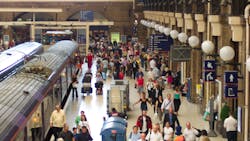Re-imagining Stations as the Center of Sustainable Urban Life
Despite the setbacks presented by the pandemic, commuter rail remains one of the most efficient and sustainable way to bring people to cities. As people return to urban centers for work and pleasure, and as they continue to grow and grapple with congestion, cities will need to invest in improving and expanding their rail stations and infrastructure.
However, the urban rail stations of tomorrow have the potential to do far more than accommodate growing capacities. They will play an increasingly central role for people as amenity-rich, multi-functional facilities, which address a spectrum of work/life needs. For cities, they can be vibrant mixed-use hubs that catalyze regeneration and significantly impact surrounding communities.
People First
First and foremost, the future station will need to reflect a fundamental human-centric shift that focuses on the well-being of passengers, the public and those of the surrounding community. This includes accommodating a range of needs across generations and diverse cultures with inclusive station design strategies, such as incorporating resting places, moving walkways and intuitive wayfinding. Incorporating green landscaping in public areas and utilizing natural light wherever possible will become increasingly important to provide healthy, restorative spaces while contributing to sustainability goals.
In a world of growing customization and convenience, stations will also need to enable passengers to make the best use of their time. Users will expect customized journeys with efficient connections and digital technology that allows them to flow through gateless stations. Future stations may also play a larger part in supporting users’ productivity by catering to their lives 24/7. Amenity spaces may include co-working and study spaces for commuters and students, drop-in clinics, doggy day care, as well as community and event spaces.
Mobility Hubs
A key part of this expanded function for stations will be their need to seamlessly connect passengers to an ever-evolving range of transit modes. Rail stations have the opportunity to become bustling, multimodal hubs and provide safe and accessible infrastructure that integrates bicycles, e-scooters and emerging transit modes in addition to taxis and private ridesharing services. At the same time, they have the opportunity to encourage walkability and enhance fluid pedestrian connectivity to the local street network and adjacent buildings.
Arup’s work enhancing the Zuid Station, a metro and rail station in Amsterdam, included accommodating the substantial number of cycling commuters with a safe, designated route to generous underground bike parking that seamlessly connects to trains, trams, buses and the metro. Pedestrian pathways are equally intuitive and accessible, with covered outdoor walkways to protect commuters from the elements as they move between buses and tram stops.
Stations as Destinations
The station of tomorrow must embrace at least one feature of its past: the grand moments and exalted experiences of Victorian-era train halls. Even smaller urban rail and subway stations can provide dynamic spaces that invite people in, transform their transit journey and elevate the surrounding neighborhood. Fulton Center in New York City, which opened in 2014, was tasked with both creating easy access and transfers between 10 subway lines and establishing an important public destination with retail shops to re-energize Lower Manhattan following its devastation from 9/11. The center’s glazed exterior provides accessible entries from the street and enticingly reveals its interior: an open multi-level public atrium lined with a dramatic sculptural cable net of reflective panels that pulls natural light into the space. It is a place of wonder and delight for passersby as well as commuters while affording clear sightlines to help orient passengers to the different subway lines.
Community Catalyzer
With appealing high-quality, publicly-oriented spaces, stations can not only be good neighbors but also powerful influencers. As integral parts of neighborhoods, they can transform their districts and catalyze economic growth. More common in Europe and Asia than in the United States, transit-oriented development often integrates housing and retail around stations as part of a holistic plan.
The Kings Cross District in London is a key example of this. Once an industrial wasteland, the area drew interest for the Eurostar London terminal at the district’s St. Pancras railway station. A vision for redevelopment was followed by intensive studies and local input in 2001, with goals to honor the district’s rich and varied history, repurpose its industrial buildings and capitalize on its canal-side setting. Further transit improvements to help galvanize this vision included the upgrade of the King’s Cross St. Pancras Underground station and redevelopment of the historic King’s Cross station, which was completed in 2012. The latter is now a dynamic transport hub that directly links all three stations, becoming a destination in its own right.
Today, the 67-acre area around the King’s Cross station continues its transformation into a thriving mixed-use district with a strong sense of local community. Its homes, shops, offices, galleries, bars, restaurants, schools and even a university convey the district’s history and cultural flavor. Perhaps what makes the King’s Cross development so successful is precisely its strong identity, which is authentically rooted in its historical and even more recent past.
Depending on what is relevant to local needs and contexts, stations may evolve to become decentralized productivity centers, cultural hubs or generators of community businesses. The goal will always be to establish a focus and identity that meaningfully responds to and is expressive of the community where the station resides.
Expanding the Role
With national attention focused on transit infrastructure investment as well as the need for increased housing, there is greater potential than ever for urban rail stations across the nation to use mixed-use redevelopment to achieve broader city and community goals. Especially as cities look to reinvigorate districts ravaged by the pandemic, station redevelopment is an important strategy for economic regeneration. In some cases, by sheer proximity, they can activate surrounding commerce by bringing in more foot traffic and business. But they can also aim to play a more active, expanded role in economic development by providing places and programs that enhance community initiatives. Such approaches might include providing spaces for learning and discovery with lectures and job fairs; supporting skills workshops run by local businesses; and partnering with community organizations and businesses to generate apprenticeships in targeted growth fields.
At the same time, embracing this larger role will often mean designing in urban contexts of ever greater complexity without a proportional increase in space, all with a large constellation of end-users and stakeholders. Stations that aim to support broader socioeconomic benefits will need to rigorously integrate public and community input to achieve results that align with local redevelopment goals and create meaningful impact. Not least, within these space constraints, urban stations have to function effectively while designing for emergency spaces, energy savings and resiliency. And with an eye to future proofing their redevelopment investment, stations must become agile spaces with built-in flexibility, enabling them to support new functions, technologies, behaviors and transit trends.
The challenges for urban stations today are considerable. As they take us to a new era of transportation, stations must uphold their civic role to positively contribute to their urban environments. This includes embracing ways to maximize public space and creatively envisioning new roles to elevate their communities. As powerful strategic assets, the urban station has tremendous potential to bring real transformation to the nation’s cities and people.
-----
Gillian Blake is a principal at Arup, leading the infrastructure team in New York. She has a wide range of experience in various transport, railway and mass transit projects as well as associated developments in the U.S., Canada, Hong Kong, Singapore and Europe. Blake has led multidisciplinary design teams in station designs ranging from transport planning to architectural fit-out.

Gillian Blake | Principal, Arup
Gillian Blake is a Principal at Arup leading the Infrastructure team in New York. She has a wide range of experience in various transport, railway and mass transit projects as well as associated developments in the US, Canada, Hong Kong, Singapore and Europe. Gillian has led multidisciplinary design teams in station designs ranging from transport planning to architectural fit-out.


